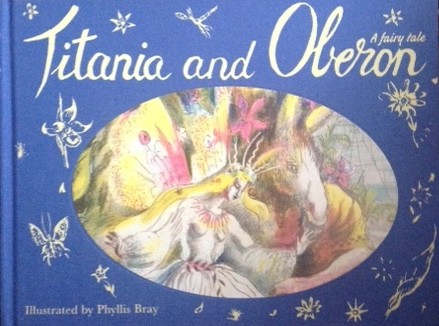Inspiring Young Readers
 posted on 18 Aug 2021
posted on 18 Aug 2021
Titania and Oberon with text by Jo Manton and illustrations by Phyllis Bray
There are times when the reissue of a book isn’t just a rediscovery of an otherwise dormant nugget of publishing history but an act of genuine artistic endeavour. This 2017 book from Pavilion Books is definitely from the latter category and what a wonderful thing it is.
With all due respect to Jo Manton’s skilful enough retelling of the Titania and Oberon strand of Shakespeare’s A Midsummer Night’s Dream, it really isn’t the text here that dazzles. The star of the show is undoubtedly the illustrations provided by Phyllis Bray that take this book out of the ordinary and launch it into the stratosphere.
And the publishers are sensitive enough to know what they have got on their hands. This whole reissue begins with an informative and well-judged mini-biography of Bray as an artist.
Born in 1911, Bray was a graduate of the famous Slade School of Art, where, even as a student, her talent was recognised and she won a number of awards and prizes. But her true flowering as an artist came in the early 1930s when she became a member of London Group of artists and they would go on to form the nucleus of the East London Group. Community art was very much at the centre of Bray’s artistic endeavours and she collaborated on a number of public murals but her individual work took her into commercial areas such as poster art and children’s book illustration.
As is the case with so many women artists, her range and skills were never given the sort of profile they deserved but she remained an active and hugely highly respected artist within the fine art community, with galleries holding significant exhibitions of her work through the Fifties. She died in 1991.
The original publication of Titania and Oberon was in 1945 and it enjoyed a reprint in 1953 with the Jo Manton text. The introduction to this edition demonstrates just how much thought went into its preparation:
“This edition of Titania and Oberon uses the original artwork for the story. The cover also reproduces the original art, although since publication letters have come to light between Bray and her publisher, debating the colour used as background. Apparently the artist was not happy with the colour originally chosen (deep red). With this in mind, this edition uses one of Bray’s more favoured colours (a purple/blue) on the cover.”
The illustrations are undoubtedly of their time and there is more than a hint of Edward Bawden and Eric Ravilious here but equally they aren’t simply derivative of other styles. The sweeping double page spreads are truly theatrical – even suggesting, I think, stage sets for operas in their style and execution. She captures fairyland in a riot of muted and subtle colours and although this isn’t fine art, it’s full of dynamism and verve.
This is a lovely book for child and adult alike and will please either market. Copies can be found for well under £10 – which just has to be something of a steal.
Terry Potter
August 2021


